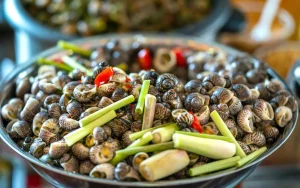magiccarouselsundays.com – Oc, or Vietnamese snails, are a beloved culinary delight found throughout Vietnam. Known for their diverse flavors and textures, these sea snails are a popular choice for street food enthusiasts and seafood lovers alike. With a variety of preparation methods and sauces, Oc offers a unique and exciting taste of Vietnamese cuisine.
The Cultural Significance of Oc
In Vietnam, snails have long been a staple in the culinary world, often enjoyed as a communal dish shared among friends and family. Eating Oc is not just about the food; it’s an experience that brings people together in lively snail restaurants or bustling street stalls. This communal aspect highlights the importance of food in Vietnamese culture as a means of fostering social connections.
Varieties of Oc
Vietnam boasts a wide array of snail species, each offering a different taste and texture. Some of the most popular types include Oc Len (mud creeper snails), Oc Huong (sweet snails), and Ốc Móng Tay (razor clams). Each variety has its own distinct characteristics, making it possible to enjoy Oc in numerous ways.
Cooking Methods and Flavors
Cooking Methods
Oc can be prepared using a variety of cooking methods, including steaming, boiling, grilling, and stir-frying. Each method brings out different flavors and textures, allowing for a diverse culinary experience.
Flavors and Sauces
The flavors of Oc are enhanced by the sauces and seasonings used in their preparation. Common ingredients include lemongrass, garlic, chili, and fish sauce, which add depth and complexity to the dishes. Popular sauces include tamarind sauce for a tangy kick and coconut milk for a creamy richness.
How to Enjoy Oc
Eating Oc is a hands-on experience. Diners are usually provided with skewers or toothpicks to extract the snails from their shells. The snails are then dipped into flavorful sauces before being savored. This interactive eating process adds to the enjoyment and makes dining on Oc a memorable adventure.
Nutritional Benefits
Oc are not only delicious but also nutritious. They are a good source of protein, low in fat, and rich in essential minerals such as iron and calcium. This makes them a healthy addition to the diet for those looking to enjoy seafood with nutritional benefits.
Conclusion
Oc, or Vietnamese snails, offer a unique and flavorful glimpse into the vibrant world of Vietnamese cuisine. Their diverse preparation methods and communal dining experience make them a must-try for anyone visiting Vietnam. Whether enjoyed as a street food snack or a part of a larger seafood feast, Oc are sure to leave a lasting impression with their delightful taste and cultural significance.


